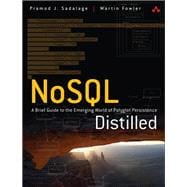
Note: Supplemental materials are not guaranteed with Rental or Used book purchases.
Purchase Benefits
What is included with this book?
Martin Fowler, Chief Scientist at ThoughtWorks, focuses on better ways to design software systems and improve developer productivity. His books include Patterns of Enterprise Application Architecture; UML Distilled, Third Edition; Domain-Specific Languages (with Rebecca Parsons); and Refactoring: Improving the Design of Existing Code (with Kent Beck, John Brant, and William Opdyke). All are published by Addison-Wesley.
Preface xiii
Part I: Understand 1
Chapter 1: Why NoSQL? 3
1.1 The Value of Relational Databases 3
1.2 Impedance Mismatch 5
1.3 Application and Integration Databases 6
1.4 Attack of the Clusters 8
1.5 The Emergence of NoSQL 9
1.6 Key Points 12
Chapter 2: Aggregate Data Models 13
2.1 Aggregates 14
2.2 Key-Value and Document Data Models 20
2.3 Column-Family Stores 21
2.4 Summarizing Aggregate-Oriented Databases 23
2.5 Further Reading 24
2.6 Key Points 24
Chapter 3: More Details on Data Models 25
3.1 Relationships 25
3.2 Graph Databases 26
3.3 Schemaless Databases 28
3.4 Materialized Views 30
3.5 Modeling for Data Access 31
3.6 Key Points 36
Chapter 4: Distribution Models 37
4.1 Single Server 37
4.2 Sharding 38
4.3 Master-Slave Replication 40
4.4 Peer-to-Peer Replication 42
4.5 Combining Sharding and Replication 43
4.6 Key Points 44
Chapter 5: Consistency 47
5.1 Update Consistency 47
5.2 Read Consistency 49
5.3 Relaxing Consistency 52
5.4 Relaxing Durability 56
5.5 Quorums 57
5.6 Further Reading 59
5.7 Key Points 59
Chapter 6: Version Stamps 61
6.1 Business and System Transactions 61
6.2 Version Stamps on Multiple Nodes 63
6.3 Key Points 65
Chapter 7: Map-Reduce 67
7.1 Basic Map-Reduce 68
7.2 Partitioning and Combining 69
7.3 Composing Map-Reduce Calculations 72
7.4 Further Reading 77
7.5 Key Points 77
Part II: Implement 79
Chapter 8: Key-Value Databases 81
8.1 What Is a Key-Value Store 81
8.2 Key-Value Store Features 83
8.3 Suitable Use Cases 87
8.4 When Not to Use 87
Chapter 9: Document Databases 89
9.1 What Is a Document Database? 90
9.2 Features 91
9.3 Suitable Use Cases 97
9.4 When Not to Use 98
Chapter 10: Column-Family Stores 99
10.1 What Is a Column-Family Data Store? 99
10.2 Features 100
10.3 Suitable Use Cases 107
10.4 When Not to Use 109
Chapter 11: Graph Databases 111
11.1 What Is a Graph Database? 111
11.2 Features 113
11.3 Suitable Use Cases 120
11.4 When Not to Use 121
Chapter 12: Schema Migrations 123
12.1 Schema Changes 123
12.2 Schema Changes in RDBMS 123
12.3 Schema Changes in a NoSQL Data Store 128
12.4 Further Reading 132
12.5 Key Points 132
Chapter 13: Polyglot Persistence 133
13.1 Disparate Data Storage Needs 133
13.2 Polyglot Data Store Usage 134
13.3 Service Usage over Direct Data Store Usage 136
13.4 Expanding for Better Functionality 136
13.5 Choosing the Right Technology 138
13.6 Enterprise Concerns with Polyglot Persistence 138
13.7 Deployment Complexity 139
13.8 Key Points 140
Chapter 14: Beyond NoSQL 141
14.1 File Systems 141
14.2 Event Sourcing 142
14.3 Memory Image 144
14.4 Version Control 145
14.5 XML Databases 145
14.6 Object Databases 146
14.7 Key Points 146
Chapter 15: Choosing Your Database 147
15.1 Programmer Productivity 147
15.2 Data-Access Performance 149
15.3 Sticking with the Default 150
15.4 Hedging Your Bets 150
15.5 Key Points 151
15.6 Final Thoughts 152
Bibliography 153
Index 157
The New copy of this book will include any supplemental materials advertised. Please check the title of the book to determine if it should include any access cards, study guides, lab manuals, CDs, etc.
The Used, Rental and eBook copies of this book are not guaranteed to include any supplemental materials. Typically, only the book itself is included. This is true even if the title states it includes any access cards, study guides, lab manuals, CDs, etc.